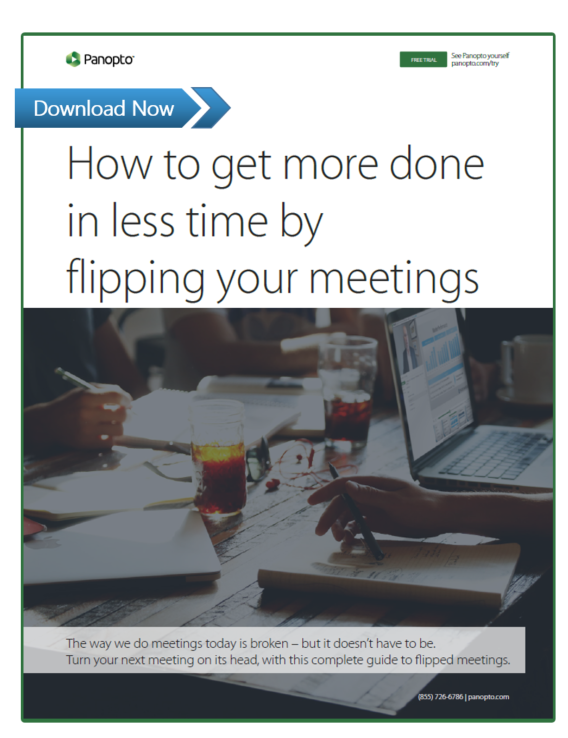- Communications
A Better Meeting Begins Before The Conference Room
Too many of our meetings start with little more than a quick agenda and a whole lot of wishful thinking.
We hope the right people will attend, that they’ll know offhand whatever information we may need, and that we can talk ourselves into a workable consensus. What we often get are partly-attended sessions with partly-informed participants, often only able to accept or reject the meeting scheduler’s ideas rather than come up with intelligent thoughts as a group.
There’s a better way: The Flipped Meeting.
It’s a new format that any organization can adopt overnight—all it requires is a simple, fundamental change in two of the expectations we have for our meetings.
Once you’ve gotten all the parties at the table, your basic flipped meeting is easy. There’s just one catch: once you’re all at the table, you’ve already missed the opportunity to flip.
Flipping a meeting requires the meeting organizer to plan—and communicate—ahead of time. Whether your next flipped meeting succeeds or fails almost always depends on the work done before anyone even opens the conference room door.
The Basics Of A Flipped Meeting: A Guide
To ensure the success of your flipped meeting, there are three essential elements you’ll need to prepare and share ahead of time:
- Your goal(s) for the meeting. You can’t flip a meeting if you don’t have anything for the assembled group to achieve. What work do you want to get done? What decisions do you want made? Be specific.
- Your driver(s) for the meeting. The meeting driver should have the authority to ensure the meeting produces results, and to act on those results. Most of the time that will be you, but you may need to prep your boss (or another member of the team) to lead in some cases.
- Your materials for the meeting. The whole point of meeting as a group is to discuss, so you’ll want a discussion guide prepared in advance. Give people the information they need in order to participate in an informed way, with enough time to reasonably review it all.
In terms of lead time, 24 hours is the gold standard. If you’re just testing out the flipped meeting format, start there and see how people react. You may find 48 or 72 hours is more suitable for your team, or instead that just a few hours notice for meetings scheduled later in the day works perfectly.
In terms of sharing information, this too will be something to test and optimize with your team. You may find the same PowerPoint deck you already create works perfectly, or that a brief bullet point outline via email suffices. Or, you may find that adopting a new model improves the outcome – Amazon now famously organizes meetings around 6-page Word documents.
Related Reading: Amazon Doubles Down On Banning Presentations In Meetings
Whatever your format, the crucial part of information sharing is actually sharing enough information for attendees to make informed decisions. Early on it may be helpful to use a documented framework to ensure the right information is shared as you work out what’s right for your organization.
The Six-Part Information Sharing Framework
- Context or Question: In 1-2 sentences, what is the issue that must be resolved or action that must be taken?
- Larger Vision: What are the overall objectives that describe at a high level what success looks like?
- Tenets: What are the enduring, guiding principles for our organization we will use to evaluate this decision or work?
- Assumptions: What are the fundamental assumptions made in formulating options? What are the key facts relevant to the decision or work at hand?
- Options: What are the main alternative options available? What are the pros and cons of each?
- Recommendation: Which option do you recommend for the audience? Why? What are the next steps?
When the Meeting Begins
While a flipped meeting requires a little more work up front, you’ll reap the rewards during the session. The key is that your role now is not to lecture, but to guide the discussion and work.
A few tips to keep your flipped meeting running efficiently:
-
- Start with a short amount of time for independent review of the meeting materials — so you’ll know everyone has read them. Try 5 minutes for a 30 minute meeting, 10 minutes for an hour.
- Assign someone to take notes. A full transcript isn’t necessary, but a good high-level summary of the positions taken and decisions made will be useful.
- Define the objective of the meeting you’re holding and repeat the goal(s). Do this at the outset to make sure everyone’s on the same page.
- Open the floor to discussion/work. That’s it! Start working toward your goal.
- Close discussion when a decision is made, work complete, or further progress is impossible. Don’t meet for a second longer than you need to.
- Summarize key outcomes and decisions. A brief email summary and a reminder of next steps will help keep the work moving. Try to have one ready for the group before the end of the day.
As with any new process, it may take time for your organization to adjust to this new way of doing business. Look for opportunities to optimize the way your team flips its meetings—to save even more time, get even more done, and make even more happen.
 Ready To Get More Out Of Your Meetings?
Ready To Get More Out Of Your Meetings?
Download our latest free white paper, “Turn Your Meeting On Its Head: A guide to flipped meetings.” In it you’ll learn why this approach is both revolutionary and simple, and we’ll walk you through using it to change the meeting culture within your organization.


